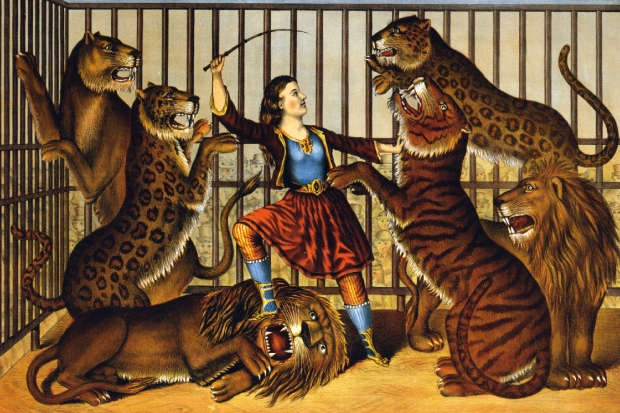Linda Simon’s compact and colourful circus history is, in many ways, a jewel of a publication. It is hard to say anything new about the circus because almost impossible to uncover quotes and stories that cannot be found in other books. The circus itself — disregarding the circus of ancient Rome — is a modern form and so the stock of images available for this type of illustrated history is quite limited and well known. But here are some interesting photographs of ceramic Mexican acrobats, and an Egyptian fresco of a female contortionist which back up one of Simon’s themes: using the body as a spectacle is an ancient impulse, of which the circus as we know it is just one manifestation.
Simon writes about the various phases of circus history in a dense, rich prose — enlivened by some superb chapter-headings, quotes and anecdotes. Here is an eclectic and well-chosen compilation of responses to, and illustrations of, the circus. She cites a brilliant essay by E.B. White, for instance, where he writes about the rehearsal process — ‘For me the circus is at its best before it has been put together’ — and describes the compelling sight of a young rider warming up on a vaulting horse: ‘The delicious satisfaction of having a perfectly behaved body and the fun of using it to do a trick most people can’t do.’

The text is studded with these gem-like responses to the circus, which Henry Miller called ‘a tiny closed off arena of forgetfulness’. There are some fascinating examples, too, from some of the more eccentric fringes of Victorian circus culture, including Mr Waterbury’s private circus in America, where ‘gentlemen of leisure’ were the performers. Simon’s exploration of the 19th-century trend for private circuses puts paid to the myth that it is only in this century that middle-class kids have run away to the circus. It has always been a place of quite extraordinary diversity; and this, too, is one of the book’s themes.
Simon is great on the subject of the unsurpassed Lillian Leitzel, the famous aerialist who used to perform up to 200 full-arm body turns while the crowd chanted ‘a magic incantation’. She includes an extensive discussion of female circus performers: they were well ahead of their time in their revealing body stockings, although Simon could have gone further into the sexual politics of performance.
The chapter on freak shows asks who is exploiting whom, and what it was to be a freak in a circus. She starts to touch on an interesting theme, that the freak show was a kind of liberation of body perceptions which made a statement that we are all freaks in our own way, but leaves the topic all too soon. And some of the case studies — for example the terrible exploitation of Saartjie Baartman, ‘the Hottentot Venus’ — don’t really back up the notion that the freak show was ‘liberating’.
I wished, too, that Simon had spent much less time looking at the fine-art depictions of certain acts and speculating on what artists ‘see’ in the circus. She says the circus is a ‘site of freedom, power and enchantment’ — a statement so filled with high-concept words that it becomes meaningless. One of the reasons that the circus has always attracted painters is that the performers are generally convivial and polyglot, and happy to be looked at and studied. Also, the circus is itself — and not by accident — a tableau vivant. Behind the scenes there are designers at work making it look the way it does; so in some ways a painting of a circus is a painting of a painting. She says of Degas’s famous ‘Miss La La at the Cirque Fernando’ that ‘only two individuals matter in this painting: a voyeur and an exhibitionist.’ I really don’t agree: the costume designer and the architect whose work fills the painting are just as present.

A somewhat starstruck concluding chapter on contemporary circus is not as well-researched as the rest of the book. It includes a detailed study of two or three contemporary — mainly American — companies, but in one paragraph skims over the groundbreaking work of the French director Bartabas, whose work is hastily compared to that of the equally brilliant, but in no way similar, Victoria Chaplin. These two artists, in particular Bartabas, have influenced a whole new generation of circus producers around the world. They should have been top of the bill in that chapter.
I enjoyed this book greatly, but in the end I wanted to read a more cut-and-thrust account of circus history, less wide in spectrum, more deep in political analysis. Linda Simon is clever, and a thorough researcher. When she hits her stride, and stops being dazzled by the circus lights, she writes with a sharp eye for detail and page-turning momentum.






Comments